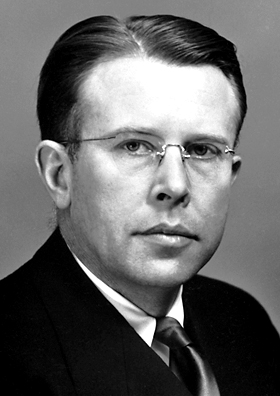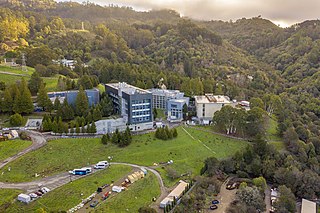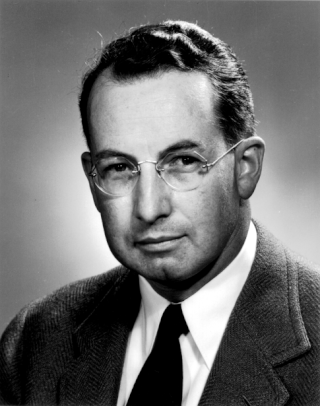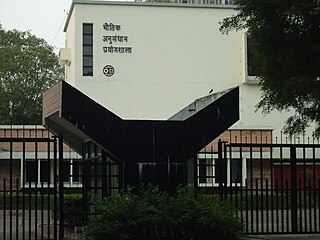Related Research Articles

The Semi-Automatic Ground Environment (SAGE) was a system of large computers and associated networking equipment that coordinated data from many radar sites and processed it to produce a single unified image of the airspace over a wide area. SAGE directed and controlled the NORAD response to a possible Soviet air attack, operating in this role from the late 1950s into the 1980s. Its enormous computers and huge displays remain a part of cold war lore, and after decommissioning were common props in movies such as Dr. Strangelove and Colossus, and on science fiction TV series such as The Time Tunnel.

Ernest Orlando Lawrence was an American nuclear physicist and winner of the Nobel Prize in Physics in 1939 for his invention of the cyclotron. He is known for his work on uranium-isotope separation for the Manhattan Project, as well as for founding the Lawrence Berkeley National Laboratory and the Lawrence Livermore National Laboratory.

Lawrence Berkeley National Laboratory (LBNL) is a federally funded research and development center in the hills of Berkeley, California, United States. Established in 1931 by the University of California (UC), the laboratory is sponsored by the United States Department of Energy and administered by the UC system. Ernest Lawrence, who won the Nobel prize for inventing the cyclotron, founded the Lab and served as its Director until his death in 1958. Located in the Berkeley Hills, the lab overlooks the campus of the University of California, Berkeley.

Edwin Mattison McMillan was an American physicist credited with being the first to produce a transuranium element, neptunium. For this, he shared the 1951 Nobel Prize in Chemistry with Glenn Seaborg.
The MIT Lincoln Laboratory, located in Lexington, Massachusetts, is a United States Department of Defense federally funded research and development center chartered to apply advanced technology to problems of national security. Research and development activities focus on long-term technology development as well as rapid system prototyping and demonstration. Its core competencies are in sensors, integrated sensing, signal processing for information extraction, decision-making support, and communications. These efforts are aligned within ten mission areas. The laboratory also maintains several field sites around the world.

Robert Fox Bacher was an American nuclear physicist and one of the leaders of the Manhattan Project. Born in Loudonville, Ohio, Bacher obtained his undergraduate degree and doctorate from the University of Michigan, writing his 1930 doctoral thesis under the supervision of Samuel Goudsmit on the Zeeman effect of the hyperfine structure of atomic levels. After graduate work at the California Institute of Technology (Caltech) and the Massachusetts Institute of Technology (MIT), he accepted a job at Columbia University. In 1935 he accepted an offer from Hans Bethe to work with him at Cornell University in Ithaca, New York. It was there that Bacher collaborated with Bethe on his book Nuclear Physics. A: Stationary States of Nuclei (1936), the first of three books that would become known as the "Bethe Bible".

Kenneth Tompkins Bainbridge was an American physicist at Harvard University who worked on cyclotron research. His accurate measurements of mass differences between nuclear isotopes allowed him to confirm Albert Einstein's mass–energy equivalence concept. He was the Director of the Manhattan Project's Trinity nuclear test, which took place July 16, 1945. Bainbridge described the Trinity explosion as a "foul and awesome display". He remarked to J. Robert Oppenheimer immediately after the test, "Now we are all sons of bitches." This marked the beginning of his dedication to ending the testing of nuclear weapons and to efforts to maintain civilian control of future developments in that field.

The Physical Research Laboratory is a National Research Institute for space and allied sciences, supported mainly by Department of Space, Government of India. This research laboratory has ongoing research programmes in astronomy and astrophysics, atmospheric sciences and aeronomy, planetary and geosciences, Earth sciences, Solar System studies and theoretical physics. It also manages the Udaipur Solar Observatory and Mount Abu InfraRed Observatory. The PRL is located in Ahmedabad.

The Pakistan Institute of Nuclear Science & Technology (PINSTECH) is a federally funded multiprogram science and technology research institute managed for the Ministry of Energy by the Pakistan Institute of Engineering and Applied Sciences (PIEAS).
Wilbur B. Davenport Jr. was a professor emeritus of communication science and engineering at the Massachusetts Institute of Technology (MIT), born in Philadelphia, Pennsylvania.
Albert Gordon Hill (1910-1996) was a physicist. He was a key leader in the development of radar in World War II, director of the MIT Lincoln Laboratory development of the electronic Distant Early Warning and SAGE continental air defense systems, and first chairman of The Charles Stark Draper Laboratory. He died in 1996.

The Radiation Laboratory, commonly called the Rad Lab, was a microwave and radar research laboratory located at the Massachusetts Institute of Technology (MIT) in Cambridge, Massachusetts. It was first created in October 1940 and operated until 31 December 1945 when its functions were dispersed to industry, other departments within MIT, and in 1951, the newly formed MIT Lincoln Laboratory.
John William Marchetti was a radar pioneer who had an outstanding career combining government and industrial activities. He was born of immigrant parents in Boston, Massachusetts, and entered Columbia College and Columbia School of Engineering and Applied Science in 1925. In a six-year program combining liberal arts and engineering, he earned both A.B. and B.S. degrees, followed by the graduate E.E. degree in 1931. He was employed by New York Edison as a power engineer for several years, during which time he also participated in the U.S. Naval Reserve as an Ensign.

Louis N. Ridenour was a physicist instrumental in U.S. development of radar, Vice President of Lockheed, and an advisor to President Dwight D. Eisenhower.

John Gordon King (1925–2014) was an English-born American physicist who was the Francis Friedman Professor of Physics (emeritus) at the Massachusetts Institute of Technology, the former director of MIT’s Molecular Beam Laboratory, and the former associate director of MIT’s Research Laboratory of Electronics.

Lee L. Davenport was an American physicist. He was a member of the MIT Radiation Laboratory during World War II, responsible for the development and deployment of the SCR-584 radar system.

John George Trump was an American electrical engineer, inventor, and physicist. A professor at the Massachusetts Institute of Technology from 1936 to 1973, he was a recipient of the National Medal of Science and a member of the National Academy of Engineering. Trump was noted for developing rotational radiation therapy. Together with Robert J. Van de Graaff, he developed one of the first million-volt X-ray generators.
The Experimental Semi-Automatic Ground Environment (SAGE) Sector was a prototype Cold War Air Defense Sector for developing the Semi Automatic Ground Environment. The Lincoln Laboratory control center in a new building was at Lexington, Massachusetts.

The AN/APQ-7, or Eagle, was a radar bombsight system developed by the US Army Air Force. Early studies started in late 1941 under the direction of Luis Alvarez at the MIT Radiation Laboratory, but full-scale development did not begin until April 1943. By this time US-built, higher frequency systems promising better performance over the existing British H2S radar were entering production. Eagle's even higher resolution was considered important to Air Force planners who preferred precision bombing but were failing to deliver it, and high hopes were put on the system's abilities to directly attack small targets like docks and bridges.
Carol Gray Montgomery (1909–1950) was an American physicist. Born in Denver, he earned a bachelor's degree from Caltech and a doctorate from Yale University. At Yale, he helped build an early linear electron accelerator, after which he moved to MIT in 1942, where he undertook war work at the Radiation Laboratory. He wrote or co-authored three volumes of Radiation Laboratory technical publications. He was elected a Fellow of the American Physical Society in 1938, having been nominated by the Bartol Research Foundation where he and his collaborators conducted experimental work with coincidence counters.
References
- 1 2 Buderi, Robert (1996). The invention that changed the world (first ed.). New York, NY: Simon & Schuster. pp. 1–478. ISBN 0-684-81021-2.
- ↑ "Arthur C. Hardy" (PDF). Nature Magazine. Retrieved August 26, 2023.
- ↑ "Lee Alvin DuBridge". National Academy of Sciences.
- ↑ "Kenneth T. Bainbridge". National Academy of Sciences.
- ↑ Valley, G. E.; Anderson (1947). "A Comparison of the Abundance Ratios of Terrestrial and Meteoritic Iron". Journal of the American Chemical Society. 69: 1871–1875.
- ↑ Teng, F-Z; Dauphas, Watkins (2017). Non-Traditional Stable Isotopes. Chantilly: Mineralogical Society of America, RIMG v 82.
- ↑ Valley; Wallman (1948). Vacuum Tube Amplifiers. Radiation Lab Series, v 18: McGraw-Hill. pp. 1–743.
{{cite book}}: CS1 maint: location (link) - ↑ "Bruno Rossi" (PDF). National Academy of Sciences. Retrieved August 26, 2023.
- ↑ "Theodor von Karman" (PDF). National Academy of Sciences. Retrieved August 26, 2023.
- ↑ Valley, George E (1985). "How the SAGE development began". Annals of the History of Computing. 7 (3): 196–226. doi:10.1109/MAHC.1985.10030 – via IEEE.
- ↑ Lincoln Laboratory (August 8, 2023). "SAGE: SEMI-AUTOMATIC GROUND ENVIRONMENT AIR DEFENSE SYSTEM". SAGE. Retrieved August 8, 2023.
- ↑ Condon, E U (1968), "Final report of the scientific study of unidentified flying objects conducted by the University of Colorado." https://files.ncas.org/condon/text/contents.htm
- ↑ Valley, GE (1974) My Years at the MIT Experimental Studies Group: Some Old Facts and New Myths. 58 p.
- ↑ "Experimental Study Group". Massachusetts Institute of Technology. Retrieved August 26, 2023.
- ↑ Goldstein, Andrew (1991). "Oral History: George E. Valley". Center for the History of Electrical Engineering. Retrieved August 28, 2023.
- ↑ "George E. Valley, Jr. Prize". APS Programs. Retrieved 2023-05-16.